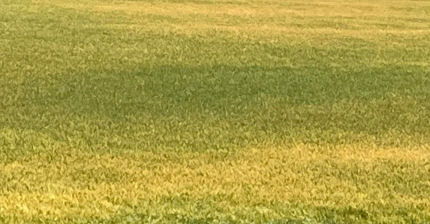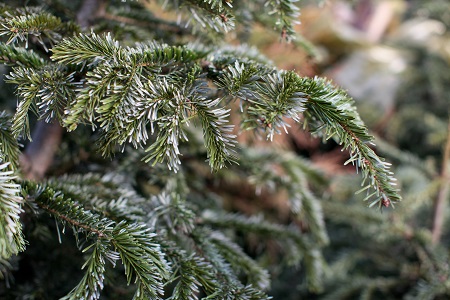Soft red winter (SRW) wheat has been a bright spot in Kansas’ otherwise challenging wheat harvest this year. According to USDA’s National Agricultural Statistics Service in the 2023 Wheat Varieties Report, SRW makes up only about 4% of the state’s wheat acreage, with hard red winter making up the majority of the balance.
In pockets of far southeastern Kansas and parts of northeast Kansas, wheat farmers plant soft red winter wheat, as those areas have climate conditions annually more suitable for SRW than HRW.
SRW typically yields higher than HRW but has lower protein content (8.5% to 10.5%), soft endosperm and weak gluten, making it targeted for different end products than HRW, universally known as the bread wheat. SRW is commonly used for specialty products such as sponge cakes, cookies, crackers and other confectionary products.
CoMark Equity Alliance (CEA), headquartered in Cheney, Kansas, and Enid, Oklahoma, has several locations in the southeastern part of Kansas, extreme south central Kansas and north central Oklahoma, that handle both soft red winter and hard red winter wheat.
Troy Presley of CEA discussed the importance of keeping the two classes of wheat segregated.
“I feel it’s especially important this year for all segments of the industry to work together to protect the integrity of both the hard red winter and soft red winter markets,” he said. “End users rely on us to provide wheat with the characteristics they need, and we don’t want to jeopardize that. It’s important to know your customers and work with your FSA office to get an idea on the percentage of each class of wheat grown in the area.”
Presley said they’ve been sending some samples to Kansas Grain Inspection Service for hardness tests, so “wheat can be labeled correctly, and we can tell our domestic and international markets, ‘this is as advertised.’”
Jay Armstrong is one of those eastern Kansas wheat farmers who plants SRW. He has finished his wheat harvest near Muscotah in Atchison County, where it’s normally too wet for high wheat yields, but this year was the exception.
Armstrong put on 160 pounds of nitrogen, fungicide and seed treatments on his SRW crop. Combined with a near-perfect growing season — he’s one of the few producers in the state that would call it so this year — Armstrong said this was “the best wheat we have ever planted.” His Pioneer 25R74 averaged 94 bushels per acre for a farm-wide yield with test weights between 60 and 61 pounds per bushel.
Armstrong binned the bumper crop for later delivery to mills near Kansas City that are looking for SRW this year. Despite the successful wheat crop, no moisture is now to be found and the soybeans going in behind the combine are being planted into dust.
In Montgomery County, where Richard Felts farms with his brother Larry, the SRW wheat — which makes up 80 percent of their operation — looked good all winter long. But, the area also suffered from a long stretch without rain.
“When it quit raining this time last year, that was the end of it until this spring,” Larry Felts said. “That’s why we needed a decent wheat crop — because we didn’t have anything for fall crops. From here you don’t have to go very far before you run into some bad stuff.”
Richard has farmed in partnership with Larry since they came back from college to partner with their father. Now, Rich’s son and son-in-law are involved in the operation and Larry’s grandson is running the grain cart — the fourth generation on the family operation.
The beginning of wheat harvest was delayed for the Felts family due to rain, finally starting around June 15. The SRW is averaging 85 bushels per acre with test weights averaging right at 60 pounds per bushel. That wheat is being delivered to the elevator in Coffeyville, which has to switch between hard and soft wheat deliveries, a tricky undertaking when both classes look similar but have very different quality characteristics… and different prices on the board.
“We’re trusting that all our neighbors are being honest, and elevators are pulling a sample on every load,” Richard Felts said. “We all want to protect the integrity of hard red winter wheat.”
The last wheat they will cut will be their HRW, but attention is already shifting to the next crop that could use some moisture as the son-in-law has started planting soybeans.
Harvest should wrap up by the end of this week in Franklin County, according to Clark Wenger, general manager/CEO of Ottawa Coop. The area planted twice as many wheat acres this year and combined with an uncommon set of great growing conditions, the harvest is better than expected.
Both HRW and SRW are planted in this area, about 30 percent soft to 70 percent hard. Ottawa Coop has taken in both classes of wheat for several years without issue because their elevator crew could visually distinguish between HRW and SRW. This year, however, certain HRW varieties started to look more like SRW. As a result, Wenger said they submitted samples to the state for grading and talked with farmers to make sure they were segregating the two classes.
Segregation between HRW and SRW is important for elevators as they market that wheat to different end-users.
“They either want soft wheat or hard wheat, they don’t want a mix,” Wenger said. “If it is a mix, then it causes problems and we’re left to market that mix into a feed market that isn’t as profitable. So, we have to make sure that what we take in is what it’s supposed to be.”
_ _ _
The 2023 Harvest Report is brought to you by the Kansas Wheat Commission, Kansas Association of Wheat Growers, Kansas Grain and Feed Association and the Kansas Cooperative Council. To follow along with harvest updates on Twitter, use #wheatharvest23. Tag us at @kansaswheat on Facebook, Instagram and Twitter to share your harvest story and photos.



